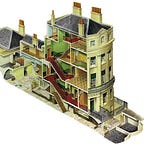The Regency Town House is a grade one listed terraced house which is currently being restored to become a Heritage centre.
Why it is significant
It represents a different side to Brighton houses than the Brighton Pavilion. The Town House is representative of many high class residential properties built for the upper classes in the beginning of the nineteenth century.
The basement annexe at number 10 Brunswick Square is unique. A real time-capsule.
The condition it’s in now and why it should be restored.
We have recently completed our first room, the housekeeper’s room at 10 Brunswick Square. Much had to be altered and that is why it has taken so long.
It’s place in history
and how the house itself and
the style has informed the development of Brighton
The Regency style, of which the Town House is an example, extended long after the Regency had finished. The building crash meant that a style popular in the 1830s continued to be used in the 1850s in Brighton. Much of the city’s architecture is Regency in style.
How has the townhouse brought together this community of volunteers.
Nick has always been reliant on volunteers. The project is too huge to tackle alone and funding has always been a problem. Volunteers have put their hands to all sorts of activities including fundraising by staging events, woodgraining, plastering, carpentry. Nick has been lucky to get the help from skilled professional (often retired) who have given their expertise for free and helped to train others. The Town House is above all else a place of learning. People volunteer to learn, for the community and friendship that the project offers.
What they hope to achieve from the restoration.
As much of the original fabric of the building is preserved as possible and all repairs to the building are done, where possible, using traditional techniques and traditional materials. Volunteers are trained to repair lath and use lime putty plaster. We regularly hold courses in lime plastering and plaster moulding to insure that these techniques are not forgotten.
What it’s been like
It’s not always an easy process. There are tales of volunteers struggling to get the basement of 10 free from pigeons just before the building was open for visitors. An experience one volunteers says that she will never forget. There are tales of rooms full to knee high with pigeon droppings which gave off heat and seemed to move. All those droppings had to be removed with countless numbers of wheel barrows and countless numbers of volunteers.
What they enjoy about it.
We’ve heard that volunteers enjoy the challenge. Nick Tyson, the curator, is keen to ensure that volunteers learn real skills and are able to work without constant supervision. Volunteers are encouraged to share their opinions and develop their own projects with Nick stepping in to add his guidance and extensive knowledge.
Nick Tyson has always had helpers to help him. The aim is to restore the Town House to how it would have been when the first occupants lived here using samples to find out colours and paint finishes. The main problem has been the cost of restoring such a large property.
5 interesting discoveries that have been made so far during the restoration.
- the pigeon hole.
- a ice larder in our courtyard at number 10
- a doll, found in the servants’ hall, belonging to the old lady who lived here until the 1990s and who arrived as a girl to the basement in the 1920s with her parents.
